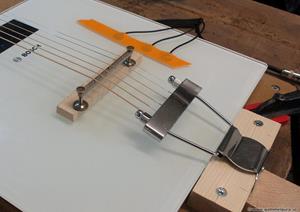In the middle of a Levin parlor with pushing stall and string holder. Since I rarely work with these, I have always been unsure of how strong the lid must be rubbed so as not to break and at the same time sound as good as it can. Despite searching the web, I have never found figures on the pressure the lid is subjected to with different height of the stable and different string thicknesses. I did a jig with my bathroom scales to get an approximate idea of what pressure in kilos the stable is exposing the lid to.
The neck of Levinen from 1929 was used in the jig. The bathroom scale acts as a lid and is level with the underside of the grip board and the mounting point for the string holder. The jig got the same length as the Levin, the tests were done with 63 cm mens watch just like on a Levin parlor.
An old adjustable stable allowed me to adjust different heights to the stable. The scale was a bit tricky, it had to be "shocked" to show the weight. I had to lift the stable with the strings strung up and let it down, then the scales began to calibrate, think a little and then show the weight. Not ideal, but it probably worked pretty well after all.
Tested three different string sets, Martin 0.10, Newtone Masterclass 0.11, John Pearse 0.12 and additionally Newtone Heritage 0.12.
The absolute values of the number of kilos may not be quite right given the cumbersome wave, but the mutual difference between the different strings should be correct since everything was measured with the scale at the same place and everything else equal except that the stall got different height. Also got the same values if I measured over more than once. Stall height in mm and pressure in kilos in the tables below.
Martin 0.10 set
15 mm - 5,7 kg
16 mm - 6,1 kg
17 mm - 6,5 kg
18 mm - 7,0 kg
19 mm - 7,5 kg
20 mm - 8,1 kg
21 mm - 8,6 kg
22 mm - 9,2 kg
23 mm - 9,9 kg
24 mm - 10,3 kg
25 mm - 10,6 kg
Newtone Masterclass 0.11
15 mm - 5,9 kg
16 mm - 6,6 kg
17 mm - 7,1 kg
18 mm - 7,6 kg
19 mm - 8,1 kg
20 mm - 8,6 kg
21 mm - 9,1 kg
22 mm - 9,6 kg
23 mm - 10,1 kg
24 mm - 10,7 kg
25 mm - 11,2 kg
John Pearse 0.12
15 mm - 6,8 kg
16 mm - 7,5 kg
17 mm - 8,2 kg
18 mm - 8,7 kg
19 mm - 9,4 kg
20 mm - 9,9 kg
21 mm - 10,6 kg
22 mm - 11,3 kg
23 mm - 11,8 kg
24 mm - 12,4 kg
25 mm - 12,7 kg
Newton Heritage 0.12
15 mm - 5,8 kg
16 mm - 6,3 kg
17 mm - 6,9 kg
18 mm - 7,4 kg
19 mm - 8,2 kg
20 mm - 8,5 kg
21 mm - 9,3 kg
22 mm - 9,6 kg
23 mm - 10,1 kg
24 mm - 10,6 kg
25 mm - 11,1 kg
One thing that I did not really emphasize was that the distance from the stable to the mounting point on the string holder is very important for what pressure the stall gets. Actually the angle of refraction above the stable. In my jig it was a distance of 15,5 cm instead of 15 cm on the Levin parlor guitar. Did another test to get some hum about how the pressure on the stable varies with the distance from the stall to the holder's attachment point.
John Pearse used the 0.12 strings. In the table the distance from the stall to the holder's attachment point and the pressure on a 20 mm high stall.
15,5 cm - 9,9 kg
16 cm - 9,7 kg
17 cm - 9,2 kg
18 cm - 8,7 kg
19 cm - 8,1 kg
20 cm - 7,7 kg
21 cm - 7,5 kg
22 cm - 6,9 kg
23 cm - 6,8 kg
24 cm - 6,4 kg
25 cm - 6,3 kg
That measurement was extra complicated when I had to move a block to attach the string holder between each measurement, then there were a little too many turns on the string at the end with the shortest distance. But it gives an idea of what effect the angle of refraction over the stable gives. With a little recalculation, you can figure out approximately what the stable gets for pressure with strings similar to the ones I tested using the difference in the current distance from the stable to the string holder's attachment point compared to the experiment's 15,5 cm 🙂
Will test the lid with a can of water calibrated to the weight of the stable height I want in the future. Instead of as before on pure intuition with the thumbs.
Now I scrap the jig and make something more sensible!



